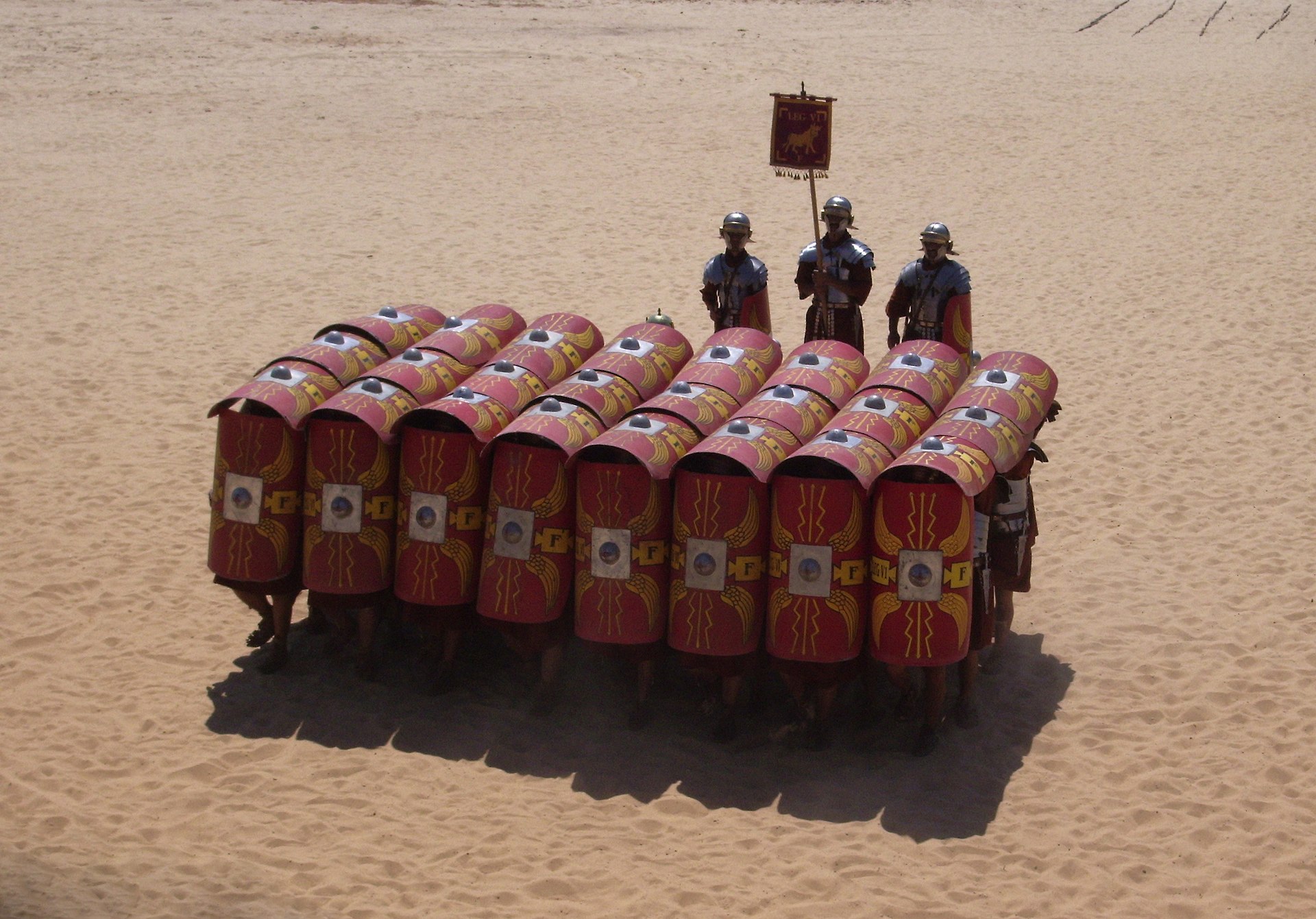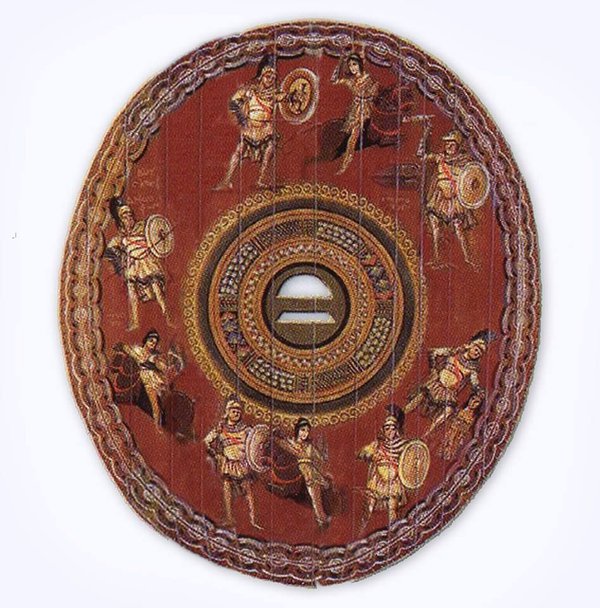A significant aspect of Roman military strength was the effective utilization of the scutum, a shield that transcended its role as a piece of defensive equipment to become a symbol of unity and duty among Roman soldiers. There is a multifaceted significance of the scutum in Roman military culture, from its design and tactical role which evolved over time.

At the core of the Roman military organization, the scutum serves as more than just a tool for protection. Its rectangular shape, crafted from wood and hide, shows symbolic decorations that reflect the pride and identity of Roman soldiers. The scutum has a profound impact on the troops, beyond its tangible role, as it signifies identity and unity among Roman soldiers, influencing their sense of camaraderie and shared purpose (Tomczak, 2013, p. 5). The intricate labeling and decorative elements on the scutum hold symbolic significance for Roman soldiers and their military units. For example, the symbols and insignia painted on the shield could indicate the specific military unit to which a soldier belonged, such as a legion or cohort. By indicating affiliations these labels not only distinguish friendly forces but also help commanders coordinate tactics and strategy amidst the chaos of combat. Additionally, these decorations might include imagery associated with Roman mythology, history, or victories, serving to inspire and motivate soldiers in battle. By visually identifying specific units or cohorts, the scutum facilitates strategic maneuvering and tactical decision-making, contributing to the overall effectiveness of Roman military operations. Moreover, they instill a sense of pride and loyalty among soldiers, reinforcing their connection to their unit and the broader Roman military tradition (Stiebel, 2014, p. 56-57).

The large size and rectangular design of the scutum provide ample coverage, facilitating formations like the “testudo” or tortoise formation. This defensive arrangement renders Roman legions nearly impenetrable to frontal assaults, showcasing the scutum’s strategic importance in ensuring battlefield dominance (Campbell, 2013, p. 419).

(Simkin, John. “Military Tactics of the Roman Army.” Spartacus Educational. Spartacus Educational Publishers Ltd. September 1997. pg. 4 )
The evolution of the scutum mirrors the dynamic nature of Roman warfare. From its humble beginnings as oval-shaped, smaller shields in the Republican period, the scutum underwent significant transformations. During the imperial era, it evolved into larger, curved versions, equipped with additional features such as the umbo for enhanced durability and offensive capability through bludgeoning opponents (Kopf, 2018, pp. 15-34). These adaptations were responses to the ever-changing tactics of Roman adversaries, such as the adoption of more organized infantry formations by enemy forces. For instance, the introduction of the manipular tactics by the Samnites prompted the Romans to modify their shield design to better suit the needs of their new battle formations. Additionally, encounters with cavalry-heavy foes like the Parthians led to innovations in shield design to provide better protection against attacks from horseback (D’Amato & Sumner, 2009, p. 229).

Beyond its physical function as a defensive tool, the scutum encapsulated a profound concept ingrained within Roman culture – the principle of pietas. This principle, deeply rooted in the Romans, instilled a sense of duty and reverence towards their nation, family, and gods. Under the guiding force of pietas, Roman soldiers were driven by a collective responsibility to safeguard their homeland and uphold the values of their society. Thus, the scutum became more than just a shield; it became a tangible embodiment of the unrelenting commitment and sacrifice demanded by the Roman principle of pietas (Ward, Riess, & Fagan, 2017, pg. 312).
The scutum evolved beyond being merely a shield to symbolize Roman military prowess, unity, and duty. Its design, functionality, and evolution highlight the adaptability and strength of the Roman military. As a significant element of Roman military strategy, the scutum serves as a testament to the enduring spirit of an empire that once dominated the known world.
References:
1. Campbell, Duncan B. “Part II Arming Romans for Battle.” The Oxford Handbook of Warfare in the Classical World (2013): 419.
2. D’Amato, Raffaele, and Graham Sumner. Arms and Armour of the Imperial Roman Soldier: From Marius to Commodus, 112 BC–AD 192. Frontline Books, 2009.
3. Kopf, Julia. “An Assemblage of Roman Military Equipment from Brigantium/Bregenz (Austria): Artefactual Evidence for the Rare Rectangular Scutum.” Gladius 38 (2018): 15-34.
4. Stiebel, Guy D., Danny Syon, Shua Amorai-Stark, Yoav Arbel, Chaim Ben-David, Baruch Brandl, Deborah Cassuto, et al. “Military Equipment.” In Gamla III: The Shmarya Gutmann Excavations 1976-1989, Finds and Studies: Part 1, 56:57–108. Israel Antiquities Authority, 2014.
5. Tomczak, Juliusz. “Roman military equipment in the 4th century BC: pilum, scutum and the introduction of manipular tactics.” Acta Universitatis Lodziensis. Folia Archaeologica 29 (2013).
6. Ward, Graeme, W. Riess, and G. G. Fagan. “The Roman Battlefield.” The Topography of Violence in the Greco-Roman World (2017): 299-324.
7. James, Simon. The Excavations at Dura-Europos Conducted by Yale University and the French Academy of Inscriptions and Letters 1928 to 1937. Final Report VII: The Arms and Armour and Other Military Equipment. Oxbow Books, 2004.
8. Simkin, John. “Military Tactics of the Roman Army.” Spartacus Educational. Spartacus Educational Publishers Ltd. September 1997.
